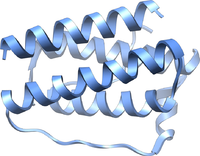
Photo from wikipedia
Background/ObjectivesObesity has been associated with elevated leptinemia and vitamin D deficiency. To date, whether there is an association between vitamin D and leptin levels independent from adiposity remains uncertain. Our… Click to show full abstract
Background/ObjectivesObesity has been associated with elevated leptinemia and vitamin D deficiency. To date, whether there is an association between vitamin D and leptin levels independent from adiposity remains uncertain. Our objective was to investigate the associations between changes in 25(OH) vitamin D levels, changes in adiposity variables, and changes in leptin levels produced by a 1-year lifestyle intervention program.Subjects/MethodsSedentary men (n = 113) with abdominal obesity, dyslipidemic, and non-vitamin D supplemented were involved in a 1-year lifestyle modification program. Subjects were individually counseled by a kinesiologist and a nutritionist once every 2 weeks during the first 4 months with subsequent monthly visits in order to elicit a 500 kcal daily energy deficit and to increase physical activity/exercise habits. Adiposity mapping by computed tomography and cardiometabolic biomarkers, as well as vitamin D measurements were performed at baseline and at the 1-year visit.ResultsThe 1-year intervention resulted in a 26% decrease in visceral adipose tissue volume (from 1951 ± 481 to 1463 ± 566 cm3), a 27% decrease in leptin levels (from 12.0 ± 8.1 to 8.5 ± 7.8 ng/mL) and a 27% increase in plasma 25(OH) vitamin D concentrations (from 50 ± 18 to 60 ± 18 nmol/L, p < 0.0001). One-year increases in 25(OH) vitamin D levels were inversely correlated with 1-year changes in leptin levels (r = −0.41, p < 0.001). The association remained significant after adjustment for 1-year changes in various adiposity indices: visceral adipose tissue (r = −0.30, p = 0.0019), subcutaneous adipose tissue (r = −0.35, p = 0.0004), total abdominal adipose tissue (r = −0.31, p = 0.0015), and fat mass (r = −0.31, p = 0.001).ConclusionsIn response to a 1-year lifestyle intervention, changes in 25(OH) vitamin D levels were independently associated with changes in leptinemia after adjustment for adiposity changes. This finding supports a possible physiological link between leptinemia and 25(OH) vitamin D levels independent from adiposity and underscores the role of lifestyle modifications leading to lowered leptinemia in the clinical management of vitamin D deficiency.
Journal Title: International Journal of Obesity
Year Published: 2019
Link to full text (if available)
Share on Social Media: Sign Up to like & get
recommendations!